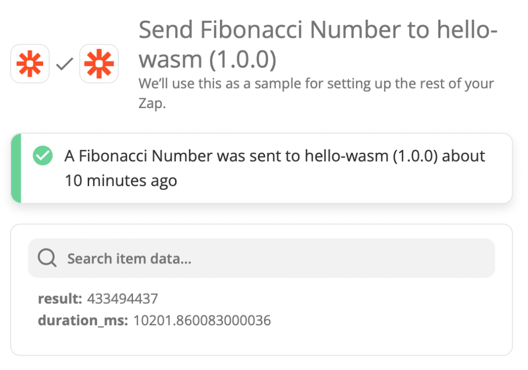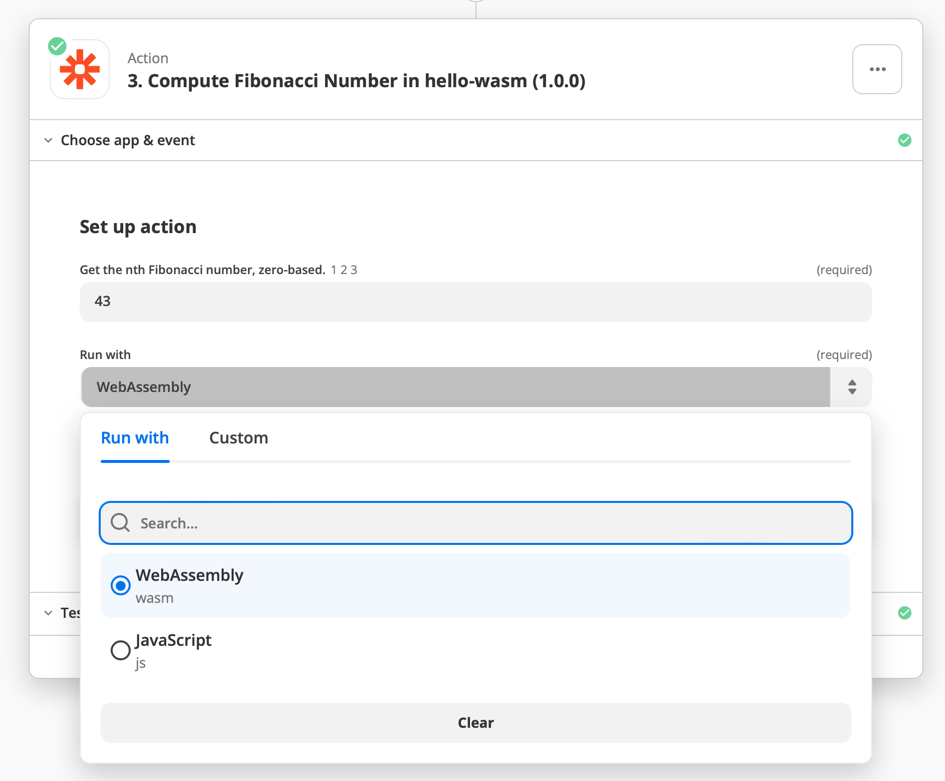An example project setup that shows how you can use Rust and WebAssembly in a Zapier CLI app.
# Install dependencies
yarn
# Compile Rust code
yarn build
# Run tests
zapier test
# Run a specific test case
yarn test -t 'make a request'
# To debug a specific test case
yarn test:debug -t 'make a request'
# Register the integration on Zapier if you haven't
zapier register 'hello-wasm'
# Or you can link to an existing integration on Zapier
zapier link
# Push it to Zapier
zapier pushFind out more on the latest docs: https://github.com/zapier/zapier-platform/blob/master/packages/cli/README.md.
In package.json, you can see yarn build actually runs this wasm-pack
command to build Rust code:
wasm-pack build --target nodejs --no-typescript
wasm-pack is the de-faco tool for building WebAssembly modules
using Rust. yarn build uses wasm-pack to compile Rust code inside src/
directory, and produce two files:
hello_wasm_bg.wasm: the wasm module. It's a binary file. To see what's actually inside, you can use the wasm2wat tool, included in the WABT toolkit, to convert it to the text format. Thebgin the filename stands for "bindgen", indicating that it's internal for wasm-bindgen.hello_wasm.js: the glue code generated by wasm-bindgen. Any other JavaScript modules won't usehello_wasm_bg.wasmdirectly. Instead, they have to importhello_wasm.jsand should only use its exported interface.
By default, hello_wasm_bg.wasm is not included by zapier build. So in
.zapierapprc, we have to include it explicitly:
{
"id": 123,
"key": "App123",
"includeInBuild": [
"hello_wasm_bg.wasm"
]
}WebAssembly is best for CPU-bound work. This Fibonacci function is a good example of that:
// creates/fib.js
const fib = (n) => {
if (n <= 1) {
return n;
}
return fib(n - 1) + fib(n - 2);
};This is a purposely bad implementation, so later we can see how fast WebAssembly can be. This is how it's implemented in Rust:
// src/lib.rs
#[wasm_bindgen]
pub fn fib(n: u32) -> u32 {
match n {
0 | 1 => n,
_ => fib(n - 1) + fib(n - 2),
}
}The #[wasm_bindgen] macro is where wasm-bindgen performs its magic, generating
the JavaScript and Rust glue code, so they can talk to each other.
In creates/fib.js, we define the perform() method like this:
const wasm = require('../hello_wasm');
// (omitted)
const perform = async (z, bundle) => {
const n = bundle.inputData.n;
const runWith = bundle.inputData.run_with;
const fibFunc = runWith === 'js' ? fib : wasm.fib;
const start = performance.now();
const result = fibFunc(n);
const duration_ms = performance.now() - start;
return {
result,
duration_ms,
};
};So on the Zap editor, it'll show two input fields to the user:
n: is used to compute the n-th Fibonacci number, i.e.,fib(n)run_with: a dropdown where you can choose JavaScript or WebAssembly
I did a test to compute fib(43) on the Zap editor. This is how they performed:
| JavaScript | WebAssembly |
|---|---|
 |
 |
So 19.3s vs. 10.2s ≈ WebAssembly is 89% faster.
This example is only for fun. I don't recommend you do it, since you'd have to deal with the type conversion mess between WebAssembly and JavaScript.
This is because WebAssembly can't do I/Os. You can't read a file like you'd normally do in Rust. The following code will still compile but it will panic at runtime:
// src/lib.rs
pub fn read_to_string() -> String {
fs::read_to_string("./README.md").expect("Something went wrong reading the file")
}However, WebAssembly allows you to import and call JavaScript functions. So if you wanted to do I/Os, like making a request, you'd have to do it in JavaScript, import it, and call it from WebAssembly.
I've come up with an example of how we can take object arguments from JavaScript
and invoke z.request() in Rust. And it's not easy:
// src/lib.rs
#[derive(Serialize, Deserialize)]
pub struct Bundle {
#[serde(rename = "inputData")]
pub input_data: Map<String, Value>,
}
#[derive(Serialize, Deserialize)]
struct Request {
url: String,
method: String,
body: Map<String, Value>,
}
#[derive(Serialize, Deserialize)]
struct Response {
status: i32,
content: String,
#[serde(default)]
parsed_content: Value,
}
#[wasm-bindgen]
pub async fn perform_request(
z: ZObject,
bundle_from_js: JsValue,
) -> Result<JsValue, JsValue> {
let bundle: Bundle = bundle_from_js.into_serde().unwrap();
let message = bundle
.input_data
.get("message")
.unwrap_or(&json!(""))
.clone();
let mut body: Map<String, Value> = Map::new();
body.insert(String::from("message"), message);
let options = Request {
url: String::from("https://httpbin.zapier-tooling.com/post"),
method: String::from("POST"),
body: body,
};
let options_for_js = JsValue::from_serde(&options).unwrap();
let response_promise = Promise::from(z.request(&options_for_js));
let response_for_js = JsFuture::from(response_promise).await?;
let mut response: Response = response_for_js.into_serde().unwrap();
response.parsed_content = serde_json::from_str(&response.content).unwrap();
Ok(JsValue::from_serde(&response).unwrap())
}Not only do we have to serialize/deserialize to convert data between JavaScript and WebAssembly (using serde), but we also have to glue promises (using js-sys) between the two worlds.
